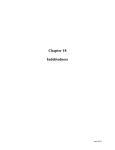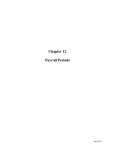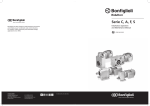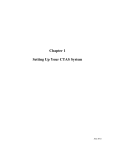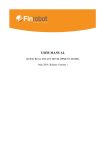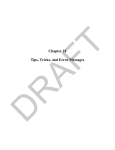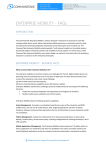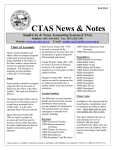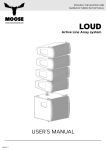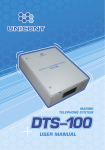Download Chapter 8: Chart of Accounts
Transcript
Chapter 8 Chart of Accounts June 2012 This Page Left Blank Intentionally June 2012 CTAS User Manual 8-1 Chart of Accounts: Introduction The Chart of Accounts provides a systematic means by which a local government codes its financial transactions. Coding is the use of numerical designations, in lieu of words or names, for the identification of specific funds or accounts. The chart of accounts is divided into five elements, which include: (a) the funds; (b) the revenue (receipt) accounts; (c) the expenditure (disbursement) accounts; (d) the object code classifications; and (e) program codes. Your chart of accounts should be designed to capture the financial information you need in order to keep track of your financial data and make good financial decisions. In deciding what to include in your chart of accounts you will want to consider each of the following questions: What reports do you want to prepare? What financial decisions, evaluations and assessments do you want to make on a regular basis? What level of detail do you require? Note: CTAS requires you to use the Chart of Accounts as defined in publication “Minnesota City and Town Accounting and Financial Reporting Standard – Uniform Chart of Accounts” published by the Office of the State Auditor. The basic account structure has four dimensions: fund, account, object code, and program code. Three digits are assigned to the fund, five to the account, three to the object code and three to the program code. The basic structure in the Uniform Chart of Accounts, then, is as follows: Fund Number Account Number Revenues xxx 3xxxx Expenditures xxx 4xxxx Object Code Program Code* xxx xxx xxx * The program code is optional Office of the State Auditor June 2012 CTAS User Manual 8-2 Accessing the Chart of Accounts Section To access the Chart of Accounts section from within the Accounting Module of CTAS, click on the Acct No. icon. The Chart of Accounts screen, as shown below, will appear: By selecting the appropriate tab, you can Add, Edit or Delete a fund number, account number, object code or program code from the Chart of Accounts screen. In addition, by clicking the Reports button, you can print a list of the fund numbers, account numbers, object codes or program codes. Instructions on how to use these buttons can be found later in this chapter. Office of the State Auditor June 2012 CTAS User Manual 8-3 Chart of Accounts: Funds - Introduction A fund is defined as a fiscal and accounting entity with a self-balancing set of accounts. Funds are segregated for the purpose of carrying on specific activities or objectives under special regulations, restrictions or limitations. It is recommended that separate funds be created only where necessary for operational or legal requirements. Too many funds may cause unnecessary complexity. The following types of funds and account groups should be used by local governments: 1. Governmental Funds are those types of funds through which most governmental functions are typically financed. The governmental funds, and how they're used: The General Fund (100) - to account for all financial resources except those accounted for in another fund. It is the main operating fund of the government. Special Revenue Funds (200 – 299) - to account for revenues derived from specific revenue sources (other than those for major capital projects) that are legally restricted for specific purposes. Debt Service Funds (300 - 399) - to account for the accumulation of resources for the payment of general long-term debt principal and interest. Capital Projects Funds (400 - 499) - to account for financial resources to be used for the acquisition or construction of major capital facilities (other than those financed by proprietary funds). 2. Proprietary Funds are used to account for a government's organizations and activities that are similar to the private sector. Enterprise Funds (600 – 699) - to account for operations that are financed and operated in a manner similar to private business enterprises, i.e. a government’s business-type activities. 3. Fiduciary Funds (800 - 899) are trust and agency funds used to account for assets held by a governmental unit in a trustee capacity or as an agent. Fiduciary funds cannot be used to support the government’s own programs. For more information on funds and assigned numbers, see the publication “Minnesota City and Town Accounting and Financial Reporting Standard – Uniform Chart of Accounts” published by the Office of the State Auditor. For a copy of the Chart of Accounts see www.auditor.state.mn.us/other/ctas/docs/ctas_coa.pdf. Note: CTAS requires you to use the Chart of Accounts as defined in publication “Minnesota City and Town Accounting and Financial Reporting Standard – Uniform Chart of Accounts” published by the Office of the State Auditor. Office of the State Auditor June 2012 CTAS User Manual 8-4 Chart of Accounts: Adding a New Fund To add a fund number, click the Fund (F3) tab. Next, click on the Add button. After the Add option is selected, a New Fund screen will appear, allowing you to enter the information for the new fund. An example of the New Fund screen is shown below. When the New Fund screen appears, complete the following steps: Enter the new fund number. For CTAS to run properly, a fund number must be three digits. Check the Active box. Enter the name of the fund in the Description box. A fund name is limited to 25 characters. Click the Save button to add the new fund. Office of the State Auditor June 2012 CTAS User Manual 8-5 Chart of Accounts: Changing a Fund To change a fund's number, description, or status, highlight the fund on the Chart of Accounts screen and click the Edit button. After the Edit option is selected, the Update Fund screen will appear: On the Update Fund screen you can change the status of the fund, the fund number, and/or the description. The status of the fund can only be changed from active to inactive when the fund balance is zero and the fund has not been used in a transaction during the current fiscal year. When a fund number is changed, all transactions associated with the fund will also reflect the new fund number. To complete the updating of the fund, click the Save button. Office of the State Auditor June 2012 CTAS User Manual 8-6 Chart of Accounts: Deleting a Fund The need to delete a fund could result from a decision that the fund was not needed after it was added, or because the fund was included as part of the chart of accounts when CTAS was installed and you do not use that fund. Note: You can only delete a fund number if it has not been used in any transactions. To delete a fund, highlight the fund and click the Delete button. Note: You can only delete a fund if it has not been used in any transactions. After the delete option is selected, the Confirm Fund Delete screen appears (see below, left). Click on the Yes button to delete the fund. You will then receive a screen message (below, right) that indicates the fund was deleted. Click the OK button to complete the process. Office of the State Auditor June 2012 CTAS User Manual 8-7 Chart of Accounts: Printing a List of the Funds To print a list of the funds, click on the Reports button on the Chart of Accounts screen. A Reports screen will appear, listing the four reports that can be printed in this section. To print a list of the funds, highlight Funds and click the Run button. Office of the State Auditor June 2012 CTAS User Manual 8-8 Chart of Accounts: Printing a List of the Funds (continued) After clicking the Run button, the print preview (System Reports screen) appears, as shown below. After reviewing the preview, click on the Printer icon to begin the printing of the report. You can close the System Reports screen by clicking the red “X”. After clicking on the Printer icon, the Printer Details screen appears: By clicking the From Page radio button, you can choose to print only certain pages of the report. The Number of Copies box allows you to enter the number of copies you would like printed. After selecting the printer details, click on the Print button to begin printing the report. A sample of the report appears on the next page. To close the printing of the report: Click the Red “X” icon on the System Reports screen. Click the Exit button on the Reports screen. Office of the State Auditor June 2012 CTAS User Manual 8-9 Chart of Accounts: Printing a List of the Funds (continued) Sample Chart of Accounts - Funds Report Office of the State Auditor June 2012 CTAS User Manual 8-10 Chart of Accounts: Account Numbers - Introduction Revenue/Receipt Accounts The primary classification of revenues is by fund and source. Major revenue source classifications are taxes, licenses and permits, intergovernmental revenues, charges for services, fines and forfeits, special assessments, and miscellaneous revenues. The revenue account (source code) is used to identify the source of the revenues. The major sources of revenue are: Taxes General Property Taxes Tax Increments Hotel-Motel (Lodging) Tax Gravel Tax Franchise Taxes Forfeited Tax Sale Apportionments Licenses and Permits Business Licenses and Permits Alcoholic Beverage Non-Business Licenses and Permits Building Permits Animal Licenses Intergovernmental Revenues Federal Grants and Aids Community Develop. Block Grant Emergency Preparedness Federal Payments in Lieu of Taxes Federal Emergency Management Act State Grants and Aids Local Government Aid Gas Tax/Highway Use Tax Residential Market Value Credit Agricultural Market Value Credit Manufactured Home Market Value Credit Taconite Homestead Credit Taconite Municipal Aid Grants and Aids From Local Governmental Units County Grants for Highways Grants from Local Governments Office of the State Auditor Charges for Services General Government Filing Fees Public Safety Police and Fire Contracts Ambulance Revenues Highways and Streets (Road and Bridges) Refuse Collection Charges Culture – Recreation Recreation Fees Library Use Fees Park Fees Airport Revenues Cemetery Revenues Fines and Forfeits Court Fines Parking Fines Library Fines Forfeits Special Assessments Miscellaneous Revenues Interest Earnings Donations from Private Sources Enterprise Fund Revenues Water Sales Sewer Charges Refuse Charges Electricity Sales Liquor Stores Sales Golf Course Revenues Arena Revenues Swimming Pool Revenues June 2012 CTAS User Manual 8-11 Chart of Accounts: Account Numbers - Introduction (continued) Expenditure/Disbursement Accounts Expenditures are to be classified according to character, function (or program), activity and object. The expenditure accounts provide the classification by function and activity, and the object code provides the character and object classification. This method of describing expenditures (use of both expenditure accounts and object code) permits analysis and aggregation of data in different ways and for different purposes. The primary classification of expenditures is by function and activity. The major functions and subfunctions in the Uniform Chart of Accounts are: General Government City Council\Town Board Mayor City/Town Clerk Financial Administration Personnel Administration City/Town Hall Health Health Public Safety Police Fire Ambulance Building Inspection Civil Defense Animal Control Conservation of Natural Resources Public Works Highways, Streets and Roadways Sanitation Culture-Recreation Recreation Parks Libraries Urban and Economic Development Urban Redevelopment and Housing Economic Development Debt Service Principal Payments Interest Payments Miscellaneous For more information on account numbers and the assigned numbers, see the publication “Minnesota City and Town Accounting and Financial Reporting Standard – Uniform Chart of Accounts” published by the Office of the State Auditor. For a pdf copy of the Chart of Accounts see www.auditor.state.mn.us/other/ctas/docs/ctas_coa.pdf. Note: CTAS requires you to use the Chart of Accounts as defined in publication “Minnesota City and Town Accounting and Financial Reporting Standard – Uniform Chart of Accounts” published by the Office of the State Auditor. In addition, if you are creating accounting numbers they must be an unused number be within the category range. For example, a new Streets and Highways (Road and Bridge) account number must be in the 43100 – 43199 range. Office of the State Auditor June 2012 CTAS User Manual 8-12 Chart of Accounts: Adding a New Account Number To add an account number click on the Account Numbers (F4) tab on the Chart of Accounts screen. Next, click on the Add button. After the Add option is selected, a New Account Number screen will appear: To enter the information for the new account number, complete the following steps: Enter the new account number in the Number box. The revenue/receipt numbers are the 30000 numbers, and the expenditure/disbursement account numbers are the 40000 numbers. Enter the name of the account into the Description box. The account name is limited to 25 characters. Click the Save button to add the new account number. Office of the State Auditor June 2012 CTAS User Manual 8-13 Chart of Accounts: Changing an Account Number To change an account number, highlight the account number on the Chart of Accounts screen and click the Edit button. After the Edit option is selected, the Update Account Number screen will appear: On the Update Account Number screen, you can change the account number and the description. When an account number is changed, all transactions associated with the account number will also reflect the new number. To complete the updating of the account number, click the Save button. Office of the State Auditor June 2012 CTAS User Manual 8-14 Chart of Accounts: Deleting an Account Number The need to delete an account number could result from a decision that the account number was not needed after it was added or the account number was included as part of the chart of accounts when CTAS was installed and you do not use that account number. Note: You can only delete an account number if it has not been used in any transactions. To delete an account number, highlight the account on the Chart of Accounts screen and click the Delete button. After the delete option is selected, the Confirm Account Number Delete screen will appear (see below, left). Click on the Yes button to delete the account number. You will then receive a screen message (below, right) that indicates the account number was deleted. Click the OK button to complete the process. Office of the State Auditor June 2012 CTAS User Manual 8-15 Chart of Accounts: Printing a List of the Account Numbers To print a list of the Account Numbers, click on the Reports button at the bottom of the Chart of Accounts screen. The Reports screen will appear, listing the four reports that can be printed in this section. To print a list of the account numbers, highlight Account Numbers and click the Run button. Office of the State Auditor June 2012 CTAS User Manual 8-16 Chart of Accounts: Printing a List of the Account Numbers (continued) After clicking the Run button, the print preview (System Reports screen) appears, as shown below. After reviewing the preview, click on the Printer icon to begin the printing of the report. You can close the System Reports screen by clicking the red “X”. After clicking on the Printer icon, the Printer Details screen appears: By clicking the From Page radio button, you can choose to print only certain pages of the report. The Number of Copies box allows you to enter the number of copies you would like printed. After selecting the printer details, click on the Print button to begin printing the report. A sample copy of the report is on the following pages. To close the printing of the report: Click the Red “X” icon on the System Reports screen. Click the Exit button on the Reports screen. Office of the State Auditor June 2012 CTAS User Manual 8-17 Chart of Accounts: Printing a List of the Account Numbers (continued) Sample Chart of Accounts – Account Numbers Report Office of the State Auditor June 2012 CTAS User Manual 8-18 Chart of Accounts: Printing a List of the Account Numbers (continued) Sample Chart of Accounts – Account Numbers Report (continued) Office of the State Auditor June 2012 CTAS User Manual 8-19 Chart of Accounts: Object Codes - Introduction In addition to the function/activity classification, expenditures should be classified according to object class. The object indicates the type of item purchased or service obtained. The four major classifications by object class are: Personal Services This category includes expenditures for salaries, wages, and related employee benefits provided for all persons employed by the city, including elected officials. Employee benefits include employer contributions to a retirement system, insurance, sick leave, severance pay, and similar benefits. Supplies This category includes articles and commodities which are consumed or materially altered when used, such as office supplies, operating supplies, repair and maintenance supplies, and small tools and minor equipment. Other Services and Charges This category includes expenditures for services other than personal services. Examples of such changes include professional services, communication, transportation, advertising, printing and binding, insurance, utility services, repair and maintenance, rentals, and depreciation. Capital Outlays This category includes expenditures which result in the acquisition of or additions to fixed assets. While classification at this aggregated level is acceptable for financial reporting purposes, you will require a greater level of detail for management and budgeting purposes. Object codes should be assigned to provide a level of detail that meets your internal and external reporting requirements without undue complexity. For more information on object codes and the assigned numbers, see the publication “Minnesota City and Town Accounting and Financial Reporting Standard – Uniform Chart of Accounts” published by the Office of the State Auditor. For a copy of the Chart of Accounts, see www.auditor.state.mn.us/other/ctas/docs/ctas_coa.pdf. Note: CTAS requires you to use the Chart of Accounts as defined in publication “Minnesota City and Town Accounting and Financial Reporting Standard – Uniform Chart of Accounts” published by the Office of the State Auditor. In addition, if you are creating object codes there must be an unused number be within the category range. For example, a new Operating Supply object code must be in the 210-219 range. Office of the State Auditor June 2012 CTAS User Manual 8-20 Chart of Accounts: Adding a New Object Code To add an object code, click on the Object Codes (F5) tab on the Chart of Accounts screen. Next, click on the Add button. After the Add option is selected, a New Object Code screen will appear, allowing you to enter the information for the new object code: When the New Object Code screen appears, complete the following steps: Enter the new object code in the Code box. For CTAS to run properly, the object code must be three digits. Enter the name of the object code in the Description box. The name is limited to 25 characters. Click the Save button to add the new object code. Office of the State Auditor June 2012 CTAS User Manual 8-21 Chart of Accounts: Changing an Object Code To change an object code, highlight the object code you wish to change and click the Edit button on the Chart of Accounts screen. After the Edit option is selected, the Update Object Code screen will appear: On the Update Object Code screen, change the object code number and the description. When an object code is changed, all transactions associated with the object code will reflect the new number. To complete updating the object code, click the Save button. Office of the State Auditor June 2012 CTAS User Manual 8-22 Chart of Accounts: Deleting an Object Code The need to delete an object code could result from a decision that the object code was not needed after it was added, or an object code was included as part of the chart of accounts when CTAS was installed and you will not use that object code. Note: You can only delete an object code if it has not been used in any transactions. To delete an object code, highlight the object code and click the Delete button. After the delete option is selected, the Confirm Fund Delete screen appears (see below, left). Click on the Yes button on the Confirm Fund Delete screen to delete the object code. You will then receive a screen message (below, right) that indicates the object code was deleted. Click the OK button to complete the process. Office of the State Auditor June 2012 CTAS User Manual 8-23 Chart of Accounts: Printing a List of the Object Codes To print a list of the object codes, click on the Reports button on the Chart of Accounts screen. A Reports screen will appear, listing the four reports that can be printed from this section. To print a list of object codes, highlight Object Codes and click the Run button. Office of the State Auditor June 2012 CTAS User Manual 8-24 Chart of Accounts: Printing a List of the Object Codes (continued) After clicking the Run button, the print preview (System Reports screen) appears, as shown below. After reviewing the preview, click on the Printer icon to begin the printing of the report. You can close the System Reports screen by clicking the red “X”. fter clicking on the Printer icon, the Printer Details screen appears: By clicking the From Page radio button, you can choose to print only certain pages of the report. The Number of Copies box allows you to enter the number of copies you would like printed. After selecting the printer details, click on the Print button to begin printing the report. A sample of the report can be found on the next page. To close the printing of the report: Click the Red “X” icon on the System Reports screen. Click the Exit button on the Reports screen. Office of the State Auditor June 2012 CTAS User Manual 8-25 Chart of Accounts: Printing a List of the Object Codes (continued) Sample Chart of Accounts – Object Codes Report Office of the State Auditor June 2012 CTAS User Manual 8-26 Chart of Accounts: Program Codes - Introduction Program codes are designed to track an activity across funds, account numbers and object codes. By assigning a program code, you will be able to print a report the shows all revenues received and all expenditures made for a coded activity. Program codes are not required when entering transactions. In addition, the Chart of Accounts does not have defined program code numbers; you can assign numbers to meet your needs. Adding a New Program Code To add a program code, click on the Program Codes (F6) tab on the Chart of Accounts screen. Next, click on the Add button. After the Add option is selected, a New Program Code screen will appear, allowing you to enter the information for the new program code: When the New Program Code screen appears, complete the following steps: Enter the new program code in the Code box. For CTAS to run properly, the program code must be three digits. Enter the name of the program in the Description box. The name is limited to 25 characters. Click the Save button to add the new program code. Office of the State Auditor June 2012 CTAS User Manual 8-27 Chart of Accounts: Changing a Program Code To change a program code, highlight the program code you want to change on the Chart of Accounts screen and click the Edit button. After the Edit option is selected, the Update Program Code screen will appear: On the Update Program Code screen, change the program code number and the description. To complete the updating of the program code, click the Save button. When a program code is changed, all transactions associated with the program code will also reflect the new number. Office of the State Auditor June 2012 CTAS User Manual 8-28 Chart of Accounts: Deleting a Program Code The need to delete a program code could result from a decision that the program code was not needed after it was added. Note: ou can only delete a program code if it has not been used in any transactions. To delete a program code, highlight the program code you want to change on the Chart of Accounts screen and click the Delete button. After the delete option is selected, the Confirm Code Delete screen will appear (see below, left). Click on the Yes button to delete the program code. You will then receive a screen message that indicates the program code was deleted (below, right). Click the OK button to complete the process. Office of the State Auditor June 2012 CTAS User Manual 8-29 Chart of Accounts: Printing a List of the Program Codes To print a list of the program codes, click on the Reports button on the Chart of Accounts screen. A Reports screen will appear, listing the four reports that can be printed from this section. To print a list of program codes, highlight Program Codes and click the Run button. Office of the State Auditor June 2012 CTAS User Manual 8-30 Chart of Accounts: Printing a List of the Program Codes (continued) After clicking the Run button, the print preview (System Reports screen) appears, as shown below. After reviewing the preview, click on the Printer icon to begin the printing of the report. You can close the System Reports screen by clicking the red “X”. fter clicking on the Printer icon, the Printer Details screen appears: By clicking the From Page radio button, you can choose to print only certain pages of the report. The Number of Copies box allows you to enter the number of copies you would like printed. After selecting the printer details, click on the Print button to begin printing the report. A sample report can be seen on the next page. To close the printing of the report: Click the Red “X” icon on the System Reports screen. Click the Exit button on the Reports screen. Office of the State Auditor June 2012 CTAS User Manual 8-31 Chart of Accounts: Printing a List of the Program Codes (continued) Sample Chart of Accounts – Program Codes Report Office of the State Auditor June 2012




































